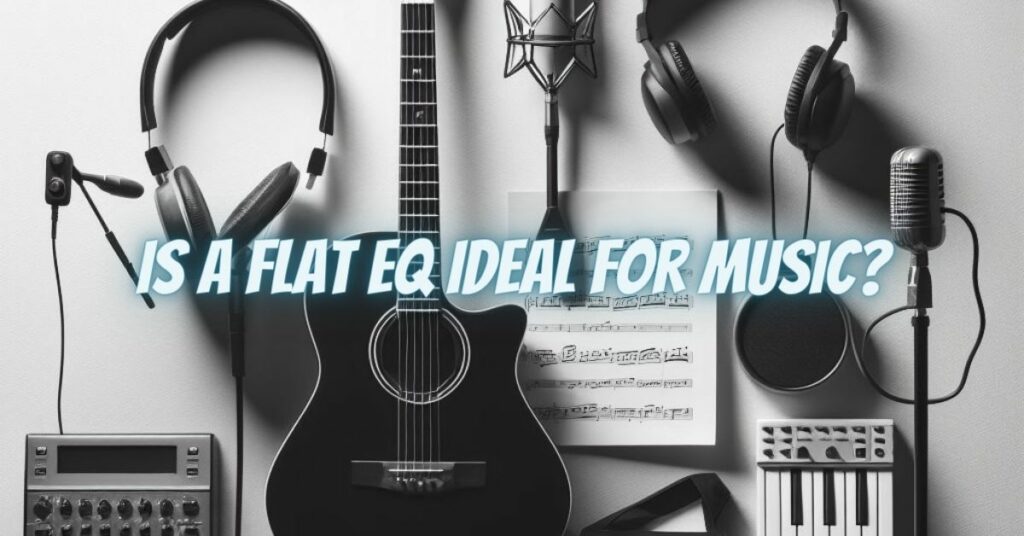The pursuit of the perfect EQ setting for music is a journey filled with nuances and subjectivity. Among the options available, the concept of a “flat” EQ, where all frequencies are reproduced at the same level, is often presented as the ideal for audio accuracy and neutrality. However, the question of whether a flat EQ is best for music is a matter of debate, hinging on individual preferences, the type of music, and the intended listening environment. In this article, we’ll explore the idea of a flat EQ for music, its advantages, potential limitations, and how personal taste and musical genres play a pivotal role in the decision-making process.
Understanding a Flat EQ for Music
A flat EQ for music involves setting all audio frequencies to the same level, with no frequency boosts or cuts. The goal is to achieve a neutral and balanced representation of the sound, as if you were hearing the music exactly as it was recorded.
Advantages of a Flat EQ for Music
- Accuracy and Transparency: A flat EQ is designed to provide audio accuracy and transparency. This can be advantageous when you want to experience the music as the artist and producer intended, free from any coloration or alteration.
- Reference Listening: A flat EQ serves as a reference point for evaluating the characteristics of audio equipment and speakers. It allows audio professionals and enthusiasts to objectively assess the quality and performance of their gear.
- Consistency: A flat EQ setting ensures that the sound remains consistent across various audio systems and listening environments. This is essential for making accurate comparisons between different audio setups.
Limitations of a Flat EQ for Music
- Subjectivity: The concept of “flat” can be subjective. What one person perceives as neutral might not align with the preferences of another individual.
- Room Acoustics: Room acoustics can significantly affect how music is heard. A flat EQ may not address room reflections, standing waves, and other factors that can impact the listening experience.
- Genre and Style: Different music genres often benefit from tailored EQ settings. Genres like rock may require more pronounced midrange frequencies, while electronic music might necessitate bass and treble adjustments.
- Personal Preferences: Personal taste plays a considerable role in determining the best EQ setting for music. What sounds “good” can vary widely based on individual listening habits and preferences.
When Is a Flat EQ Best for Music?
A flat EQ for music is best suited for situations where audio accuracy and transparency are essential. These include:
- Audio Production: In recording studios and post-production environments, a flat EQ setting serves as a reference point for creating music that will translate well to various playback systems.
- Analytical Listening: Audiophiles and audio professionals who engage in critical listening or audio analysis can benefit from a flat EQ to assess audio equipment and recordings objectively.
- Reference Point: A flat EQ can be a valuable starting point for evaluating the characteristics of audio systems, ensuring they faithfully reproduce the original source.
Personalized EQ for Musical Enjoyment
In most real-world listening scenarios, music is a form of entertainment and personal enjoyment. Speakers, headphones, and audio systems are not merely tools for audio accuracy; they are a gateway to an immersive and engaging listening experience.
Finding the ideal EQ setting for music often involves considering your favorite music genres, the acoustics of your listening environment, and your personal preferences. Whether you prefer a warmer sound with enhanced bass, a crisp and bright treble, or a balanced midrange, the best EQ setting for music is the one that enhances your enjoyment of the music. The quest for the perfect EQ setting is deeply intertwined with your individual tastes and the kind of musical experience you seek.
The quest for the best EQ setting for music underscores the delicate balance between audio fidelity and personal preferences. While a flat EQ can provide accurate and transparent audio reproduction, it may not always align with the goals of enjoyable and immersive listening experiences. The best EQ setting for music is ultimately a matter of personal choice, the desired musical outcome, and the type of music you enjoy. Whether you’re an audiophile, a casual listener, or a music enthusiast, the pursuit of the perfect EQ setting is a highly personal journey that combines the love of music with the art of sonic perfection.


